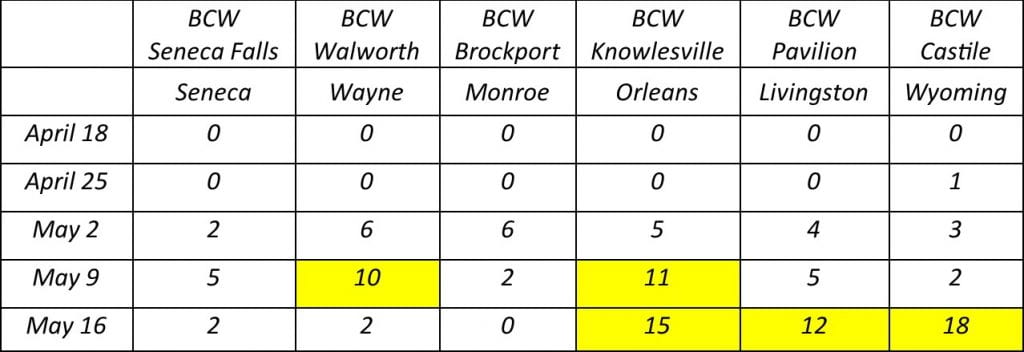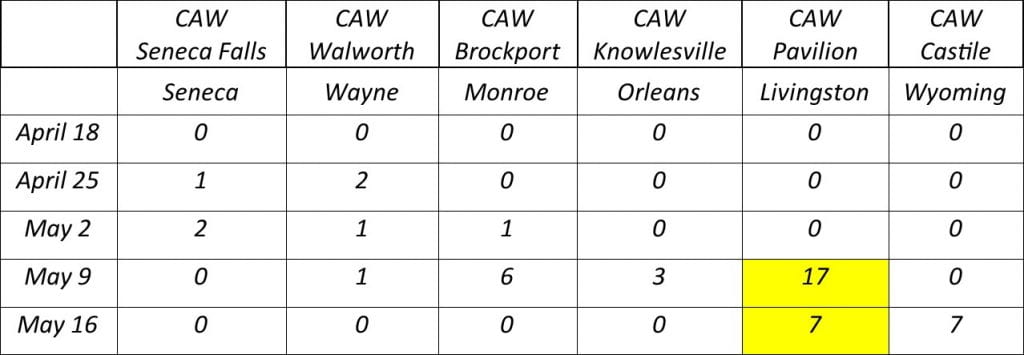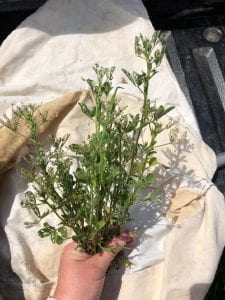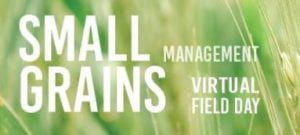Black Cutworm and Common Armyworm Moth Numbers Rising
Both Common Armyworm (CAW) and Black Cutworm (BCW) catches are still relatively low in our area but rising. There are some bigger numbers of BCW caught around the state last week, so they are definitely here laying eggs. We started to monitor degree-days (base 50°F). Lots of DD’s accumulating with this heat wave! Lots of corn in the ground!


Cereal Leaf Beetles Active in Small Grains

I have been looking for Cereal Leaf Beetle (CLB) adults in wheat with no luck. However, Barry Butski, Syngenta, sent me a picture on Friday of CLB eggs from a wheat field in Lima. All oat and wheat fields should be scouted for eggs and young larvae. Threshold is three eggs and larvae per plant or one larva per flag leaf. CLB eggs are orange and usually laid down the midrib of the leaf. Larvae are shiny and black and almost look slug-like. They cover themselves in their own excrement and are actually pale orange when clean (after a rain). They feed on the green epidermis of the leaf and their damage results in a windowpane appearance as the leaves have strips of white (see picture). Oat fields should definitely be checked before herbicides are sprayed in case you need to tank mix an insecticide.
Watch Regrowth for Alfalfa Weevil Feeding
A lot of alfalfa/grass fields went in the bunk this week. Today, Jodi found some heavy Alfalfa Weevil (AW) larvae feeding in first cut that is still out there. Those that are fortunate to have first cut in the bunk, need to scout that regrowth id AW was present. Many of the larvae are still there and getting bigger and eating more. They do 80% of their leaf feeding at the fourth instar. If you feel the alfalfa is standing still and not growing, you better take a closer look. Treatment threshold is 50% tip feeding. Randomly pick 50 stems and count the number with feeding damage. You do not have to actually look for the larvae. If 25 of those 50 stems are positive for damage, you are at 50%. Sidenote: We have not found any potato leaf hoppers yet!!!


Alfalfa Heights
Height indicators alfalfa and grass for NDF content are below:
- In general we say 100% grass stands should be cut when nearby alfalfa is 14 inches tall to achieve the desired 50% NDF.
- Begin cutting 50/50 mixed alfalfa and grass stands when nearby alfalfa is 22 inches tall for the desired 44% NDF.
- Begin cutting 100% alfalfa stands when alfalfa is 28 inches tall for desired 40% NDF.
As of today May 20, 2021 alfalfa heights averaged 22-25 inches across locations. The warm weather certainly has many farms out in their fields harvesting. Great job managing your dynamic harvest schedules and field work! It is important that you get first cutting in a timely manner for quality purposes, so please communicate in advance with your team on how you are going to prep fields, plant and successfully harvest 1st cutting.
Next report will be May 27th.
2021 Small Grains Management Virtual Field Day – June 3rd
 Due to COVID-19 restrictions, we are not able to hold our traditional, in-person Small Grains Management Field Day at Cornell’s Musgrave Research Farm this June. However, we invite you to participate in our second virtual Small Grains Field Day via Zoom. This will be an opportunity to learn about the latest in small grains development, management, and markets. All participants on the call will be invited to ask questions and make comments. No registration is required. More information and Zoom instructions are available at: https://blogs.cornell.edu/ccefieldcropnews/2021/05/19/2021-small-grains-management-virtual-field-day-to-be-held-june-3rd/#Join_Zoom_Meeting. So please plan to log-in to Zoom before 10 AM on June 3. Looking forward to hearing and seeing you on Zoom!
Due to COVID-19 restrictions, we are not able to hold our traditional, in-person Small Grains Management Field Day at Cornell’s Musgrave Research Farm this June. However, we invite you to participate in our second virtual Small Grains Field Day via Zoom. This will be an opportunity to learn about the latest in small grains development, management, and markets. All participants on the call will be invited to ask questions and make comments. No registration is required. More information and Zoom instructions are available at: https://blogs.cornell.edu/ccefieldcropnews/2021/05/19/2021-small-grains-management-virtual-field-day-to-be-held-june-3rd/#Join_Zoom_Meeting. So please plan to log-in to Zoom before 10 AM on June 3. Looking forward to hearing and seeing you on Zoom!




